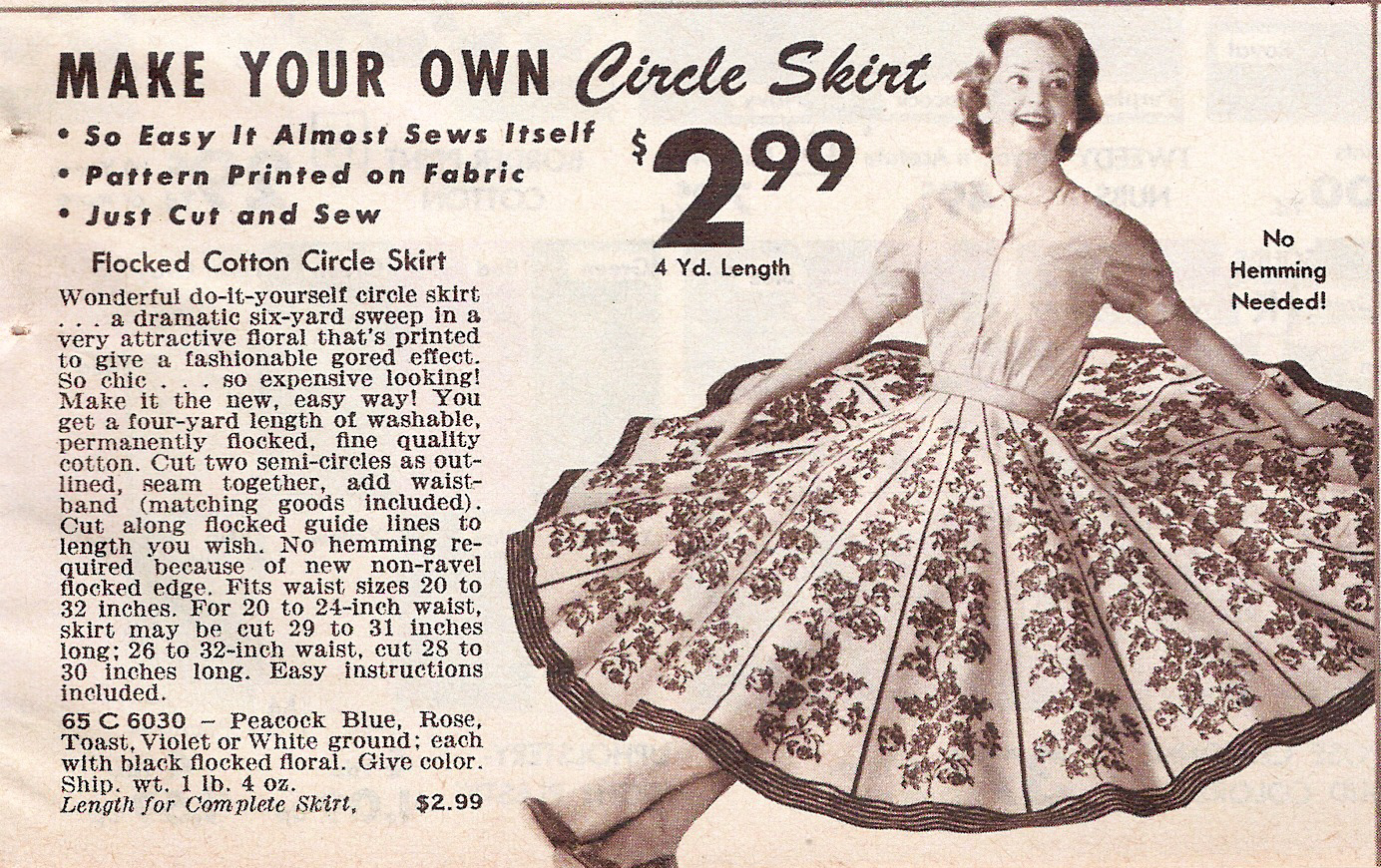Circle Skirt: Construction Notes
Vital Stats
A classic 1950s circle skirt, cut in cotton for a rockabilly/day look. I'm going to make like a billion of these, because wearing them is so fun. I just spent the evening twirling around the kitchen going WHOOOSH!Difficulty: Easy. Very recommended as a first project.
Time taken: one evening
Fabrics: mine is a printed cotton kingsize duvet, but felt is another classic choice if you can get a piece big enough.
Instructions/pattern: I actually kinda winged it, but I looked at this tutorial during my research, and it's a good one.
Another thing: For a full 50s look, you also need one or more petticoats - but these are also easy to make. Circle skirts also look OK without petticoats - they don't have the 50s silhouette, but are still fun and fashionable.
Measurements:
Another thing: For a full 50s look, you also need one or more petticoats - but these are also easy to make. Circle skirts also look OK without petticoats - they don't have the 50s silhouette, but are still fun and fashionable.
Measurements:
Skirt Length - 68cm
Tags
Other Circle Skirt Posts
Other Rockabilly Project Posts
This gives it max stability. My waistband is either on the warp or weft, but as I was using scrap duvet, didn't know how to work out which was actually the grain; and I didn't know it mattered. There is actually a subtle difference between the stronger warp - the grain - and the weft.
Center hole radius - 10cm
Center hole circumference - 64cm
My waist circumference - 75 cmTags
Other Circle Skirt Posts
Other Rockabilly Project Posts
Pattern Cutting Tips
1. MAKE THAT WAISTBAND SMALLER THAN YOUR WAIST YO
Circle skirts are always cut on the bias, which means if you make the pattern waist the same size as your waist, it will be huge. Cut a circle which is at LEAST 5inches/12cm smaller than your waist, and then incrementally shave it the circle larger until it == your waist.2. Don't make waistbands from polka dots
It just looks odd. If you line it up, it's just a row of big spots that draw the eye in a bad way. if you don't, it looks scruffy. A similar shade to the skirt, without dots, would be the best finish - or a contrast colour.

3. Cut the waistband on the grain
This gives it max stability. My waistband is either on the warp or weft, but as I was using scrap duvet, didn't know how to work out which was actually the grain; and I didn't know it mattered. There is actually a subtle difference between the stronger warp - the grain - and the weft.4. Make the waistband curved rather than rectangular
So my waistband is...I don't even know. It's not nice. I did it 4 times, and the end result is serviceable. One factor is, I think, that it is a rectangle rather than a curved band. Curved bands supposedly sit better against the body - all I know is, that mine stands up a bit like a Christmas party hat around my waist, and it's not a good look. Perhaps the interfacing is too stiff? Perhaps the band is too tall? Perhaps my ribs are weird?Construction Tips
5. Handle with care.
The central circle is, as I have said, on the bias grain and liable to stretch. This includes as you handle and sew it unless you are extremely careful. I redid the waistband 4 times, and that inner circle I so painstakingly got to the circumference of my waist? Is no longer the right size. It stretched. Bollocks. So staystitch it, and handle with extreme care to avoid stretching as you work.5. Seam the slit before adding the waistband.
You need to make a slit in the skirt at the waistband, either with a zip or left open, to fit it over your head. I totally forgot to seam or reinforce this, and can't now do it neatly without taking the waistband off.
I adapted a tutorial for making welt pockets, to use my polka dot fabric to neatly finish the slit.
I used her firm waistband technique. I tried Knight's "standard waistband" technique first, but it became clear that the interfacing I had demanded the "firm" tutorial instead.
Using a firm interfacing blocks off the waistband so the messy cutting can no longer be seen ~thumbs up~.
I adapted a tutorial for making welt pockets, to use my polka dot fabric to neatly finish the slit.
6. Use waistband interfacing
It's already rolling as I wear it. Interfacing is a stiffer fabric used as a layer under your final fabric to make things more sturdy - cuffs, collars, etc and is cheap. Complete Dressmaking Skills by Lorna Knight also has a couture technique using organza, tailor's canvas and Petersham ribbon for a sturdy waistband. A waistband constructed only from fabric will work ok, but it really needs some interfacing.I used her firm waistband technique. I tried Knight's "standard waistband" technique first, but it became clear that the interfacing I had demanded the "firm" tutorial instead.
7. Trim away seam allowances more smartly
I left mismatched allowances at the waistband, and you can actually see them through the finished fabric. Even though this is a really bold print. I could have done this whole waistband thing more neatly.Using a firm interfacing blocks off the waistband so the messy cutting can no longer be seen ~thumbs up~.
8. Let hang for a few days before doing the hem
Because it's cut on the bias, circle skirts will fall out of shape over time - gravity will tug on the stretchier parts more than on the parts on a grain. To combat this, hang it from a hanger or mannequin and let it stretch. Then, after a week come back and redraw the circle and do the hem.



Comments
Post a Comment